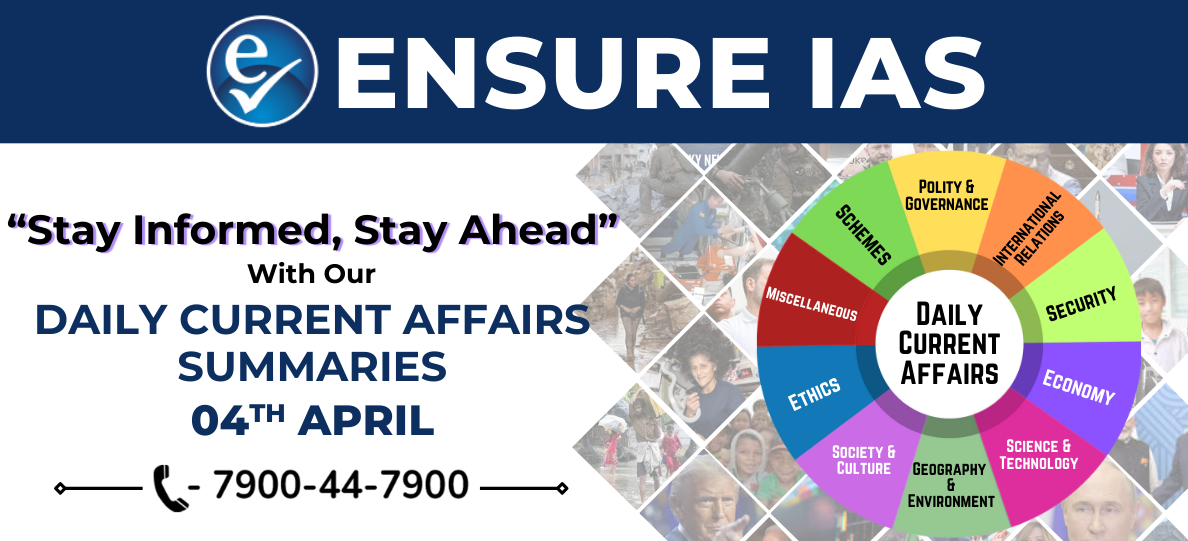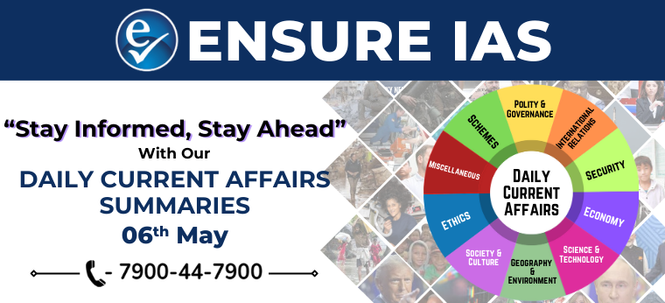- Courses
- GS Full Course 1 Year
- GS Full Course 2 Year
- GS Full Course 3 Year
- GS Full Course Till Selection
- Answer Alpha: Mains 2025 Mentorship
- MEP (Mains Enrichment Programme) Data, Facts
- Essay Target – 150+ Marks
- Online Program
- GS Recorded Course
- Polity
- Geography
- Economy
- Ancient, Medieval and Art & Culture AMAC
- Modern India, Post Independence & World History
- Environment
- Governance
- Science & Technology
- International Relations and Internal Security
- Disaster Management
- Ethics
- NCERT Current Affairs
- Indian Society and Social Issue
- NCERT- Science and Technology
- NCERT - Geography
- NCERT - Ancient History
- NCERT- World History
- NCERT Modern History
- NCERT Medieval History
- CSAT
- 5 LAYERED ARJUNA Mentorship
- Public Administration Optional
- ABOUT US
- OUR TOPPERS
- TEST SERIES
- FREE STUDY MATERIAL
- VIDEOS
- CONTACT US
Daily Current Affairs Summary - 4th APRIL 2025
Daily Current Affairs Summary - 4th APRIL 2025

Women's Role in Disaster Risk Reduction (DRR)
- A recent study titled How Does Climate Change Impact Women and Children Across Agroecological Zones in India, released by the Union Ministry of Women and Child Development (WCD), highlights the disproportionate impacts of climate change on women and children.
- It emphasizes the urgent need for gender-disaggregated data to formulate more effective and inclusive policies to address climate-induced disasters.
Women’s Contribution to Disaster Risk Reduction (DRR)
Women have increasingly become central figures in efforts to mitigate and respond to disasters. Their involvement is crucial in developing community resilience and managing disaster risks. Below are some of the key ways in which women are actively engaged in DRR:
- Aapda Mitra Scheme and Aapda Sakhi Training: Under the Aapda Mitra Scheme, women volunteers, known as Aapda Sakhi, are trained to assist in disaster response and recovery efforts.
- Nearly 20% of the 100,000 volunteers trained so far are women, playing a vital role in community-based disaster preparedness and risk management.
- SEWA’s Heat Micro-Insurance Programme: The Self-Employed Women's Association (SEWA) in Ahmedabad has introduced an innovative micro-insurance program specifically designed to protect informal female workers from the adverse effects of heatwaves.
- This initiative helps women replace income lost during extreme heat conditions, ensuring financial stability during high-risk periods.
- Gender-Responsive Disaster Management in Odisha: The Odisha State Disaster Management Authority (OSDMA) has established a dedicated gender cell to collect and analyze gender-specific data during disasters and extreme weather events.
- This initiative allows for a more comprehensive understanding of how different communities are affected and ensures that disaster management strategies are tailored to the needs of women and vulnerable populations.
Immigration and Foreigners Bill, 2025: Key Provisions and Reforms
- The Immigration and Foreigners Bill, 2025 has recently been passed by the Indian Parliament, marking a significant step toward updating and modernizing the country's immigration laws.
- The bill aims to enhance national security, streamline immigration processes, and improve coordination among various immigration authorities.
Key Highlights of the Bill:
1. The primary goal of the bill is to modernize India’s immigration framework to better address current challenges. It seeks to improve national security while ensuring a more efficient system for managing foreign nationals entering and exiting the country.
2. Repeal of Outdated Laws: The bill has resulted in the repeal of several older and outdated laws:
- Passport Act, 1920
- Registration of Foreigners Act, 1939
- Foreigners Act, 1946
- Immigration (Carriers’ Liability) Act, 2000
These laws were seen as inadequate for addressing modern immigration challenges and have now been replaced by more comprehensive regulations.
3. Immigration Regulation: A Bureau of Immigration will be established to oversee visa issuance and manage entry-exit regulations. This central body will play a pivotal role in coordinating immigration processes and ensuring the smooth functioning of the system.
4. Penalties for Illegal Entry: The bill introduces strict penalties for foreign nationals who enter India without valid travel documents, such as a passport. Offenders could face:
- Imprisonment for up to five years
- A fine of up to five lakh rupees
- Or both imprisonment and a fine
These provisions are designed to deter illegal immigration and strengthen border security.
5. Power of Arrest: Under the new law, police officers, starting at the rank of Head Constable, are authorized to make arrests without a warrant. This provision grants law enforcement more flexibility and authority in dealing with individuals who breach immigration laws.
Heard Island and McDonald Islands: U.S. Tariff Announcement & Significance
- On April 2, the U.S. President made a notable announcement regarding the imposition of reciprocal 10% tariffs on several trade partners, including Heard Island and McDonald Islands.
- In his speech, the President declared April 2 as "Liberation Day," labeling it as "one of the most important days in American history."
Overview of Heard Island and McDonald Islands
- Heard Island and McDonald Islands are remote, uninhabited subantarctic islands located in the Southern Ocean.
- These islands, despite their isolation and lack of a permanent human population, hold significant value due to their unique geological and ecological features.
Geographical and Administrative Facts:
- The islands are situated in a harsh, subantarctic environment and are administered by Australia.
- They are renowned for being the only volcanically active islands in the subantarctic region, providing a rare glimpse into ongoing natural processes.
Scientific Importance:
- As an active volcanic region, the islands offer a unique opportunity to study geomorphic changes and glacial dynamics in real-time.
- Their exceptional scientific value is recognized globally, leading to their inclusion as UNESCO World Heritage Sites.
Sentinelese Tribe: Recent Arrest and Legal Protections
- A U.S. national was recently apprehended in the Andaman and Nicobar Islands for allegedly entering the restricted tribal reserve area of North Sentinel Island.
- This island, part of the Andaman and Nicobar archipelago, is home to the Sentinelese people, a tribe considered one of the last uncontacted groups in the world.
About the Sentinelese People
The Sentinelese are an indigenous group belonging to the Negrito ethnic category, and they are one of the most isolated tribes globally. As a result of their isolation and the tribe's vulnerability, the Indian government has implemented various protections to safeguard their way of life.
Designation as a Particularly Vulnerable Tribal Group (PVTG):
The Sentinelese are classified as one of the Particularly Vulnerable Tribal Groups (PVTGs) in India. Other tribes in the Andaman and Nicobar Islands that share this classification include the Great Andamanese, Jarawas, Onges, and Shom Pens.
Legal Protections and Regulations
The Indian government has taken stringent measures to protect the tribes of the Andaman and Nicobar Islands, including the Sentinelese. In 1956, the Andaman and Nicobar Islands (Protection of Aboriginal Tribes) Regulation was enacted, which imposed the following restrictions:
- The regulation declared traditional tribal areas, such as North Sentinel Island, as reserves, prohibiting entry to all outsiders unless authorized by the authorities.
- It also criminalizes activities like photographing or filming the tribe members, aimed at preserving their privacy and preventing any potential disruption to their isolated existence.
India Steel Procurement Policy: Revised Guidelines for 2025
India has recently unveiled the Revised Domestically Manufactured Iron & Steel Products Policy-2025, which aims to bolster the preference for locally produced steel in government procurement contracts.
Key Provisions of the Revised Policy:
1. Objective: The primary goal of the policy is to prioritize the procurement of domestically manufactured iron and steel products in government contracts.
- It introduces a reciprocal clause to address trade restrictions and ensures that foreign manufacturers comply with similar requirements when exporting steel to India.
- Additionally, the policy mandates a significant level of domestic value addition for capital goods such as furnaces and rolling mills.
2. Ban on Global Tender Enquiries: The policy introduces a restriction on Global Tender Enquiries for steel procurement contracts with an estimated value up to Rs. 200 Crore.
- This means that, except with the approval of a competent authority, these contracts must only consider domestically produced steel products, preventing foreign suppliers from dominating smaller contracts.
3. Domestic Value Addition Requirement for Capital Goods: For capital goods like furnaces and rolling mills, the policy mandates a minimum of 50% domestic value addition.
- This requirement is designed to promote local manufacturing and technology development, while ensuring that Indian industries contribute to the value chain.
Unveiling of Rare Copper Plates Documenting Devaraya I’s Coronation in Bengaluru
- In a significant historical discovery, copper plates detailing the coronation of Devaraya I, a prominent ruler of the Vijayanagara Empire, have been unveiled in Bengaluru.
- These plates, which date back to the 15th century, are inscribed in a mix of Sanskrit, Kannada, and Nāgarī characters, offering valuable insights into the administrative and cultural landscape of the Vijayanagara period.
About Devaraya I (Reign: 1406-1422)
Devaraya I ruled the Vijayanagara Empire from 1406 to 1422 during the Sangama dynasty. His reign marked a period of significant political and infrastructural growth, contributing greatly to the prosperity of the empire.
Key Contributions and Achievements:
- Infrastructure Development: Devaraya I is particularly renowned for his infrastructural initiatives, including the construction of a dam on the Tungabhadra River.
- This dam facilitated canal irrigation, a vital advancement that improved agricultural productivity for both cities and surrounding villages.
- International Recognition: The prosperity and grandeur of Vijayanagara during his reign were noted by foreign travelers.
- In 1420, Italian explorer Niccolò de' Conti visited the empire and described its capital, Vijayanagara, as a magnificent city renowned for its exceptional architecture and wealth.
Expanding The Scope of National Polio Surveillance Project
- The Union Ministry of Health and Family Welfare has proposed expanding the scope of the National Polio Surveillance Project (NPSP) to track emerging infectious diseases.
- This adaptation could play a crucial role in early detection and response to new health threats across the country.
Overview of the National Polio Surveillance Project (NPSP)
The National Polio Surveillance Project is a joint effort between the Government of India and the World Health Organization (WHO), aimed at strengthening polio surveillance and monitoring in India.
Key Milestones:
- Establishment and Focus: Launched in 1997, the NPSP introduced a comprehensive surveillance system for monitoring Acute Flaccid Paralysis (AFP), a key indicator for detecting potential polio cases.
- Impact on Polio Eradication: The project significantly contributed to India’s success in eliminating polio, ensuring effective planning and implementation of immunization campaigns. This effort resulted in India being officially declared polio-free in 2014.
- Integration into National Health Framework: In 2025, the surveillance operations of the NPSP were integrated into the National Centre for Disease Control (NCDC) under the broader framework of the Integrated Disease Surveillance Programme (IDSP).
- This move aims to create a more unified and efficient system for disease surveillance across the nation.
|
Also Read |
|
UPSC Foundation Course |
|
| UPSC Monthly Magazine | CSAT Foundation Course |




